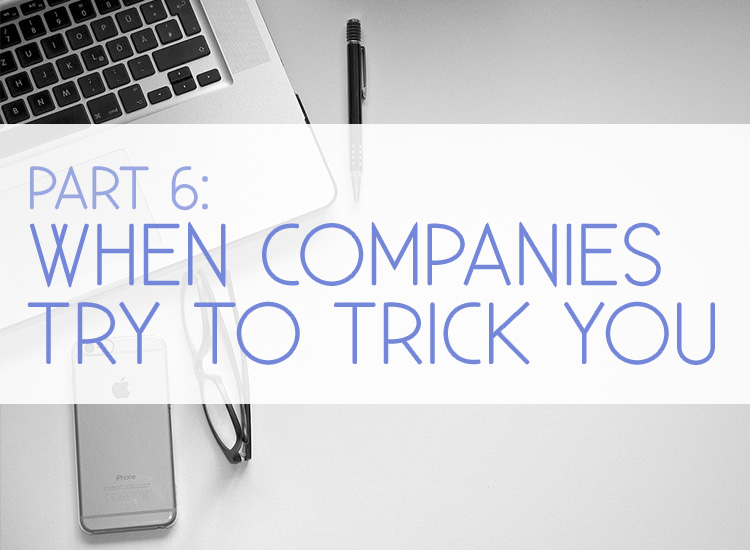
One of the most critical learning curves in running a review blog is learning to read between the lines when a company cold emails you a pitch.
Let’s say: your fledgling blog has been up a few months. You’re hammering out reviews whenever you can, you’re seeing some traffic to your site, and you’re watching your twitter numbers creep up. You’re reviewing for a couple of companies you’d approached, and life is good.
Sooner or later, whether it’s Week 2, Month 2, or Year 2 in your blog’s life, you’ll be cold emailed by a company that wants to work with you.
What’s this? Someone out there noticed your little blog? AMAZING!
Except, not always.
Sometimes, a company really is offering you a fantastic opportunity.
Often, though, it’s a really crummy idea for you. Maybe the store is just naive, or maybe they’re hoping you don’t notice.
I’ve received thousands of emails over the years from companies offering me “collaboration” opportunities that 100% benefited that company, but left me doing all the work with no reward. Sometimes it’s super obvious, and other times it’s less clear. Your task is to identify the good deals from the bad.
Just to remind non-bloggers reading this: most of us sex toy bloggers don’t blog full time — we’re students, have careers, or we’re parents… or all of the above. We have to prioritize our time carefully enough as it is just to run a little blog in the first place. It’s important to not fall for bad pitches so that we have the time and resources to sustainably blog long-term.
Luckily, bad pitches tend to fall into reliable patterns/categories. In this post, I walk you through real-life examples of bad collaboration emails I’ve received.
Other posts in this series:
- Setting everything up
- Your first reviews
- Affiliates
- Getting Products for Review
- Connecting with the Community
- When Companies Try to Trick You (here)
(1) “Let us use your content on our site for a link-back”
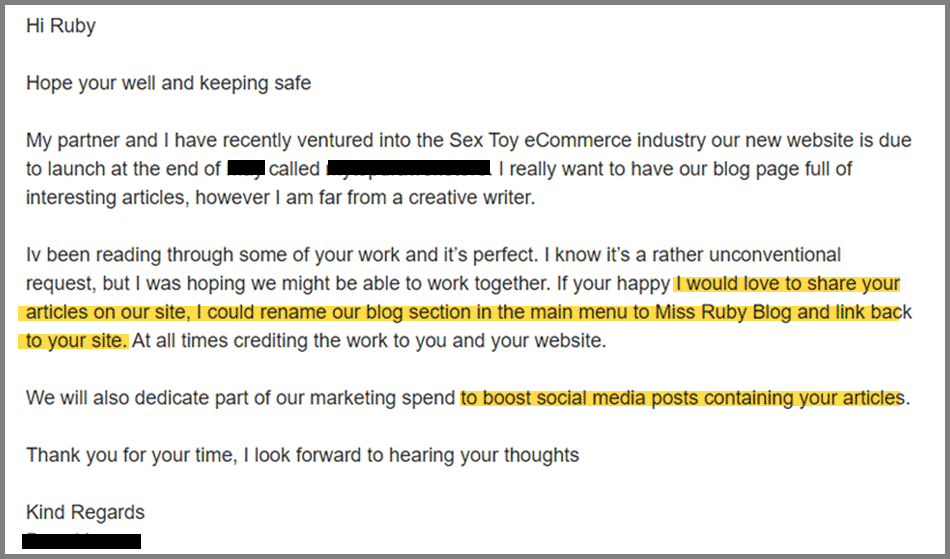
A fair few emails like this can trickle in during the month. This is one of the most obvious bad deals.
In the email above, as polite and as well-meaning as this person may be, it’s also quite naive and any blogger would be horrendously taken advantage of if they agreed. Essentially, this company is asking to copy and paste all of your hard work onto their site so that they don’t need to go hire someone to write for their store’s blog.
In return, you might be offered something like “link-backs” or “social media boosting” (I get this all the time by companies who have a much smaller social media reach than me…).
Us bloggers have worked hard to create original content for our own blogs (and the traffic and readership that comes with it). Google won’t like identical content (and will hold it against us), plus a lot of our content was sponsored by other companies… so it’s just never a good idea.
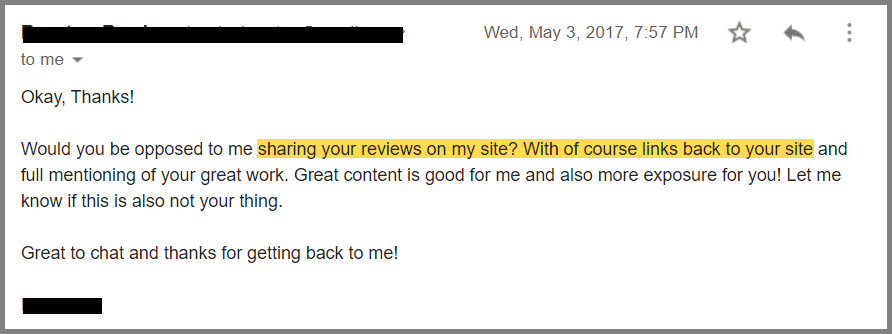
Duplication of our content is something us bloggers constantly have to issue DMCA takedown requests about — sometimes companies do it and just hope we won’t notice it, and other times they let us know they want to do it (like the examples above).
This happens when companies don’t realize/accept that, if they want their store to have a blog section, they’ll need to hire someone to write original content for it. When they’re starting a blog, stores typically should either (A) Have a dedicated in-house staff member write their blog content or (B) Pay independent bloggers like us to write content specifically for their blog. Not just copy/paste an independent blogger’s work.
Tip!
Just say no to this! NO!
(2) “Your fee is too high. Will you take $X instead?”

The above email was part of an exchange where a company wanted me to pay me only a third of my stated fee. The company wasn’t a freshling starter with no budget — they owned multiple websites.
After you tell a company your fees, sometimes you’ll be offered as low as 10%-30% your price.
That’s not negotiating… that’s just plain low-balling.
If you agree to a low-ball offer, I promise you’re going to regret it and grind your teeth every second you put into finishing the job you agreed to.
I personally start to get ticked off when a company insists on less than 75% of my fee. It’s one thing to not have a high marketing budget… it’s another to get pushy and aggressive when you can’t afford a blogger’s asking price. I’ve ended many email threads with a polite note that companies can get in touch with me when their marketing budget is more solid.
Tip!
Don’t get guilted into undervaluing your time/work. If you make a habit of this, blogging will start to feel unpleasant. Remember that your content is valuable and deserves appropriate compensation. Your blog is YOUR property, you aren’t responsible for every little pop-up sex toy company out there, and you don’t have to do any blogging work you don’t think is fair. It’s so hard to believe this when you’re new, but try to!
(3) “We’ll donate you a free sample for review”

No toy is free when you spend 12+ hours photographing, testing, and reviewing it.
I have hundreds of exhausting email threads like this in my inbox.
But you can’t pay rent with dildos. You can’t buy food with vibrators.
It’d be like your boss at your office job telling you that your payment literally IS the use of your work desk and chair for the day.
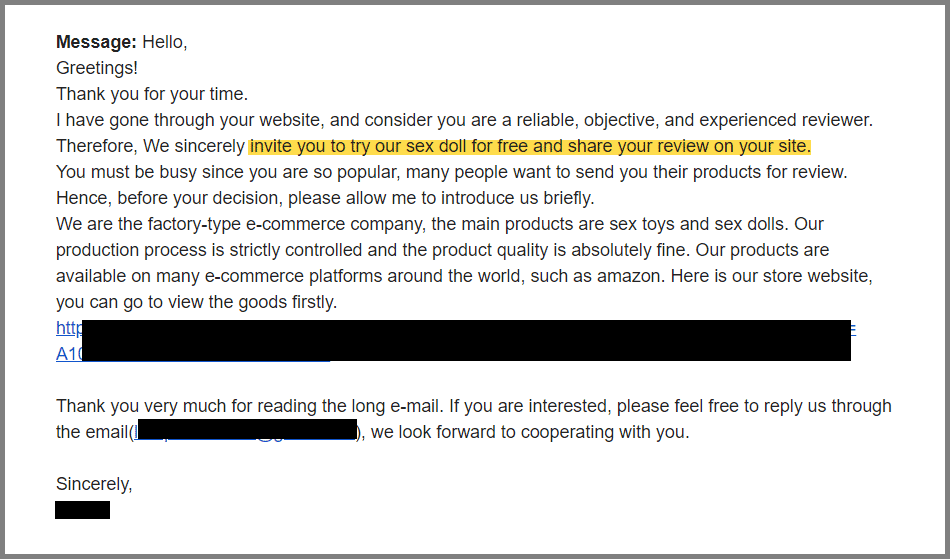
Many start-up sex toy companies are trying to get free advertising. Even if they sell their product for $70, their at-cost value could be <$10, so of COURSE they want you to dedicate a permanent review on your blog where you give them lots of links and forever send them potential buyers.
I remember a story from years ago where a blogger was included in a company’s Reply-All thread by accident — she saw the company staff patting themselves on their backs about how they were going to use her for free advertising. Companies know just how great a review can be for them.
When you’re pitched by a company to review, consider your actual tangible benefit.
- Are they offering you an affiliate commission program? We can work with that!
- Do they allow you to link to one of your affiliate distributors? Also great!
- Are they paying you upfront for your review? PERFECT!
That’s why I always look for one of these:
- (a) They have a promising affiliate program; or
- (b) They’re agreeing to pay my review fee; or
- (c) They’re a manufacturer offering me a product that’s carried by one of my affiliates.
- I include this clause in my review disclosure for this reason: [4. For non-paid reviews, if you are a manufacturer without an affiliate program, I reserve the right to link to one of your distributors with whom I have an affiliate relationship if they carry that product.]
Is there any flexibility on this one? Of course!
It’s totally okay to agree to review a toy when you know you’ll never see a penny for it. Sometimes, you want a toy so badly that you don’t care you’ll never get paid for your hours of work. I’ve certainly done this. If you want it bad enough, go for it!
Or sometimes, your blog is so small or slow that you need every ounce of review fodder you can get to keep it going. This is really common for new bloggers just getting established. I survived during my first year like this.
But, as always, just THINK carefully before agreeing to a “free sample.”
(4) “Let’s place eCPM/CPC ads on your blog so you can make money!”
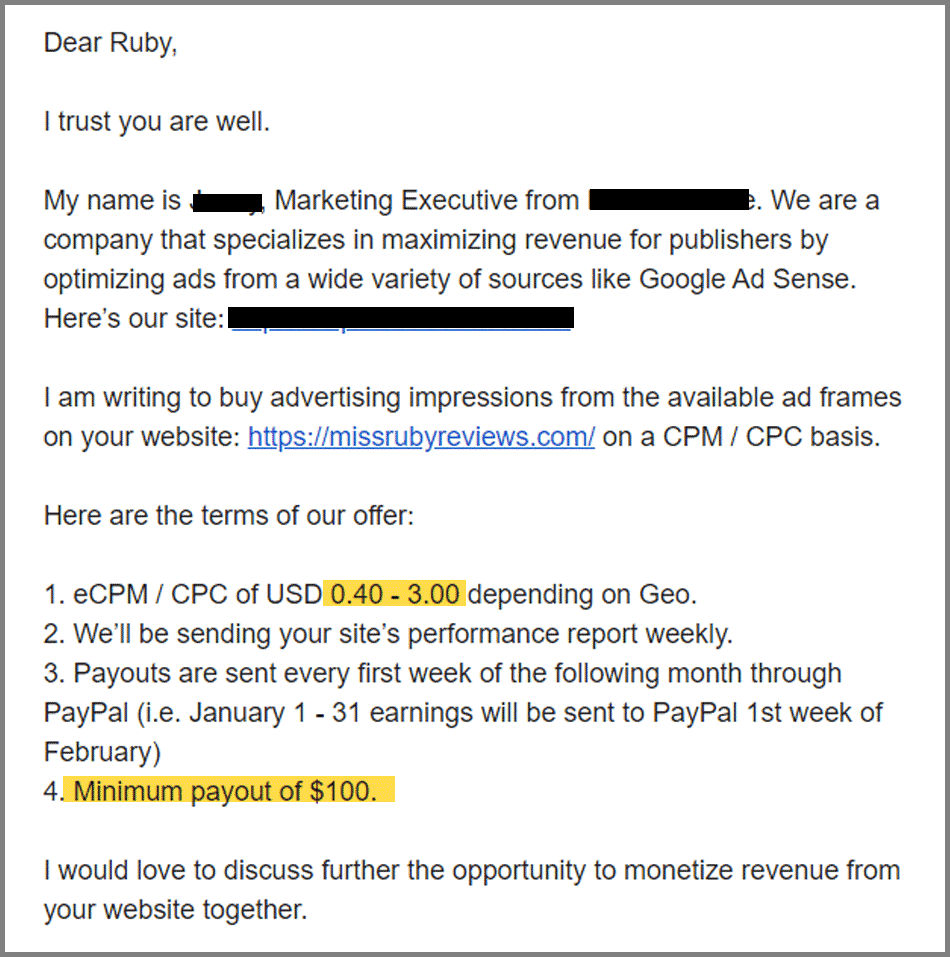
Ever visit a blog and see constant, annoying, distracting ads EVERYWHERE, and the ads seem weirdly unrelated?
Those are probably eCPM/CPC ads. If you agree, companies will place dynamic ad frames throughout your blog and display a constant stream of ads. You don’t get to control what ads are shown.
- CPC refers to Cost Per Click Bidding — meaning you’ll only get paid if someone clicks on your ad.
- CPM refers to Cost Per Thousand Impressions Bidding — meaning you’ll only get paid per THOUSAND unique people who see that ad.
If you read between the lines of the above email, I’m being offered between $0.40 to $3.00 per every 1,000 users who see that ad.
Forty cents for 1,000 users. And I’ll only get paid when I get to $100… so that means 250,000 people will have to view those ads before I get a single payout. And every single one of those readers will be irritated by those ads, so your readership will go down.
That system is GREAT for the marketing company, but NOT worth our time.
Tip!
If you’re approached about placing these kinds of ads on your blog, remember that you don’t get to control those ads, there’s usually a high minimum payout threshold, and the payout will be minuscule unless you have like a bazillion monthly hits.
(5) “We’ll donate a guest post to your site!”

Companies want to place promotional guest posts on my site all the time — this is a service that I charge for because it’s a form of advertising. Their guest post will inevitably link to the website they want to promote, either subtly or very obviously, and voila — they’ve gotten permanent advertising on my site.
But sometimes companies think bloggers aren’t very smart and won’t realize that their guest post is advertising. They assume we’ll be happy to blindly accept any content they provide us without batting an eyelid.
Often, in return for posting what they give me, I’m told that they’ll help “share the article” for me.
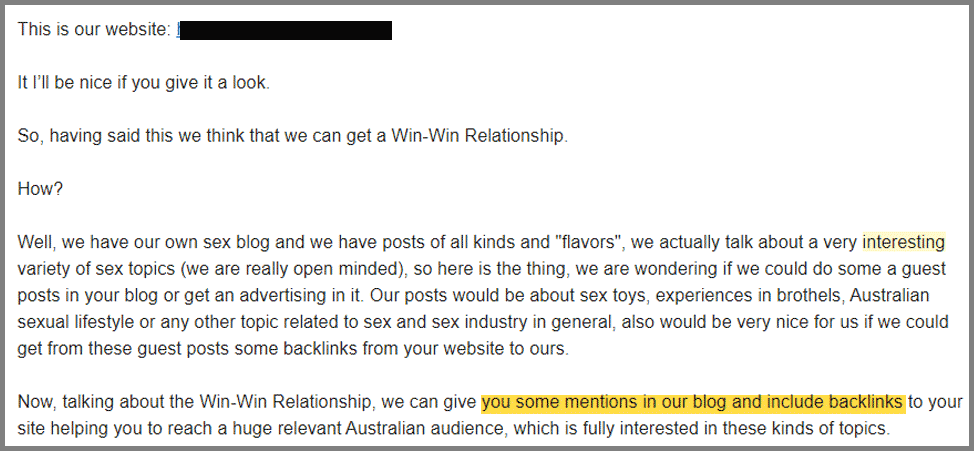
In a different recent email exchange, a new company asked for some feedback on their site’s look/feel and added “Would you be open to me writing an article for your website as my way of saying thanks? I love to write and would be honored to contribute.” Super polite, but they weren’t an independent blogger… and their site would probably eventually be for-profit.
Tip!
If someone is offering to “donate” a guest post/content to your blog, think carefully. Unless they’re another INDEPENDENT blogger, the website behind it probably is (or will become) for-profit and is simply looking for free advertising. Let them know your fees instead.
On a related note — you’ll sometimes be asked to write a guest post for a store’s blog, for free. You’ll be promised linkbacks to your blog and increased visibility across the web. I suggest you don’t do it! I did this for free twice in my first year of blogging and regretted it. It’s a lot of work for minimal (if any) “increased exposure.” This is totally something you can do, but *for a fee*.
(6) “We’ll pay you $X to place a do-follow link!”

When you insert any link in your blog, you can add attributes to it. By default, links are “follow” links, which means that Google sees your link as an endorsement of that website, and so that website’s value/rank increases a bit.
The above example is probably the most common kind of email I get. Companies DESPERATELY want quality do-follow links because it’ll raise their rank and SEO (and so help their website show up sooner in search results).
It’s also a REALLY bad idea for a blogger. If Google catches you using do-follow links for sponsored placements, you’ll take a formidable rank drop and your traffic may never recover.
Paid links must either use the no-follow or sponsored attribute. Google will then realize your link is biased in some way.
For example, if someone places a paid banner (that links to their store) on your blog. That’s obviously a paid link — so you need to use the no-follow attribute.
A less obvious example is, when I review a toy and use an affiliate link for that product, I again use a no-follow link. I do this because, theoretically, there’s a chance that I’ll get a small percentage of commission if someone clicks on that link and makes a purchase. Even though I might never get a commission from that link, I have to treat it as a paid link.

When I remind companies I only use no-follow links in ALL sponsored content (as stated in my policies), there’s often pushback. In the example above, a company is irritated that I place do-follow links to my fellow bloggers (ie, in my blogroll to bloggers I like and support), but won’t use a do-follow link to their retail website.
I can’t tell you how many times I’ve been asked to make an “exception” “just this once.”
Tip!
Don’t make any exceptions! All paid/sponsored links in your blog should be no-follow if you want to keep Google happy.
(7) “This will be interesting for your readers if you share it!”
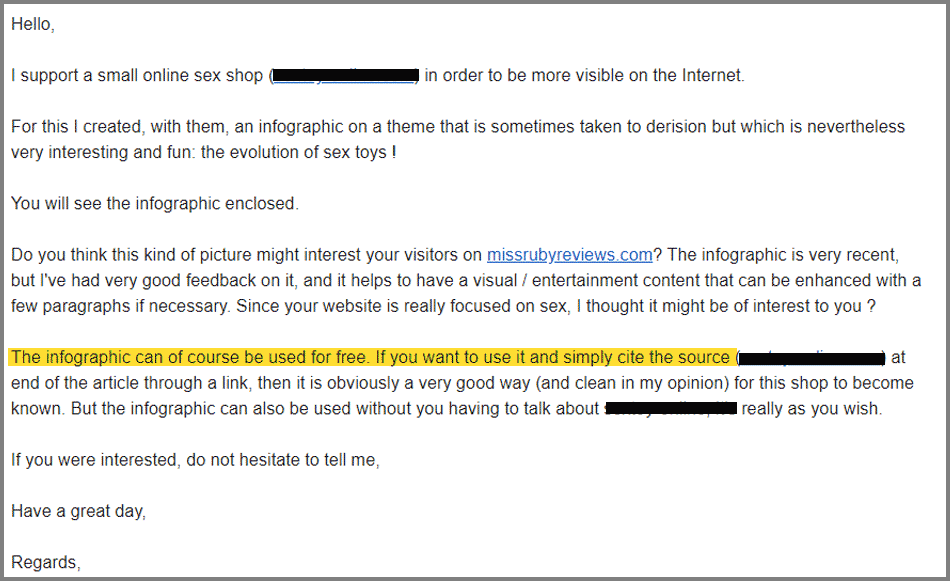
Small start-ups will often email you asking you to share their content on your blog because your readers will “definitely” find it interesting. It’ll come heavily laden with links and branding to point your audience to their store.
This can be things like infographics, e-books, coupons, and charts… and all provided to you under the guise that it’s for your readers’ benefit, not the company’s.
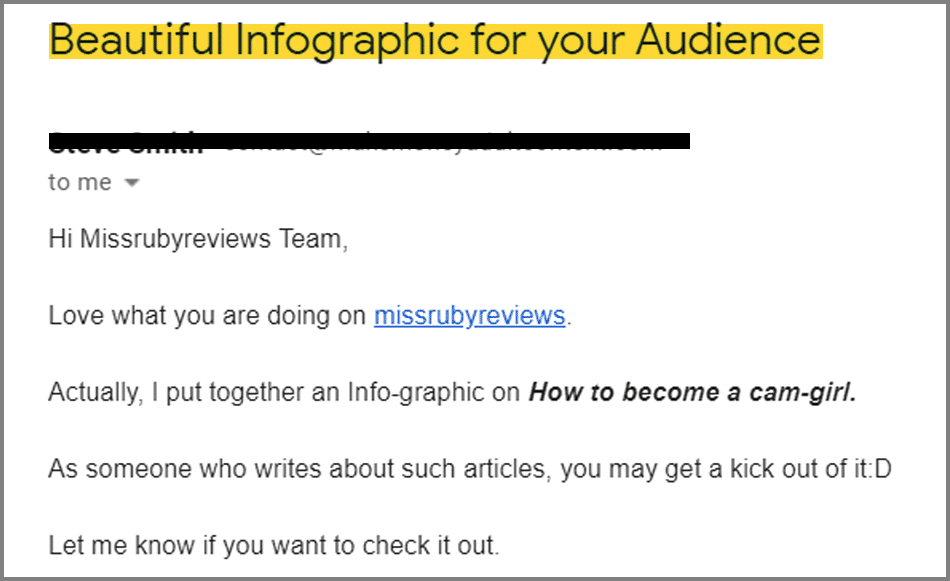
When I’ve actually looked at what was being offered to my readers, it’s rarely anything of substance. Like a 10% off coupon to an obscure store selling toys of questionable material safety (and requiring readers to spend like $300) isn’t super handy. Or it could be an infographic on a topic not super relevant to my blog, or a chart on a topic I’ve already written about.
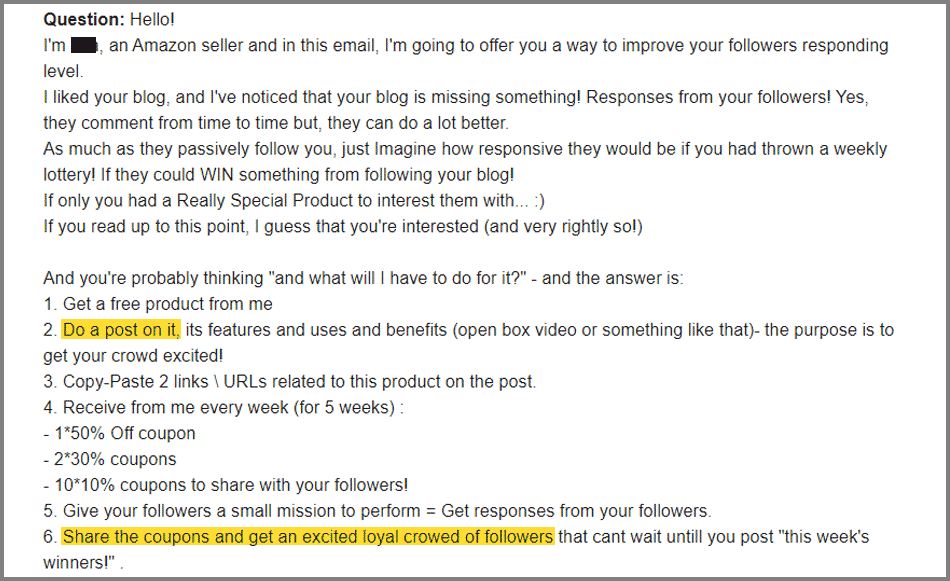
The key thing about “offers” like this is that the providing company has zero interest in paying for their content to be placed on your blog, and they also generally want do-follow links. Unless this is coming from a company you’re already affiliated with, you’re going to just end up giving free advertising again.
Tip!
If you get cold emailed (by a company you’ve never heard of) offering you “helpful content for your readers,” take a step back and think carefully. What exactly will you be encouraging your readers to click/buy if you agree to place that content on your blog? Is the company offering you any sort of commissions/payment? If you like the content, feel free to get back to them with your fees!
(8) “Give me your feedback on our site/design for free!”
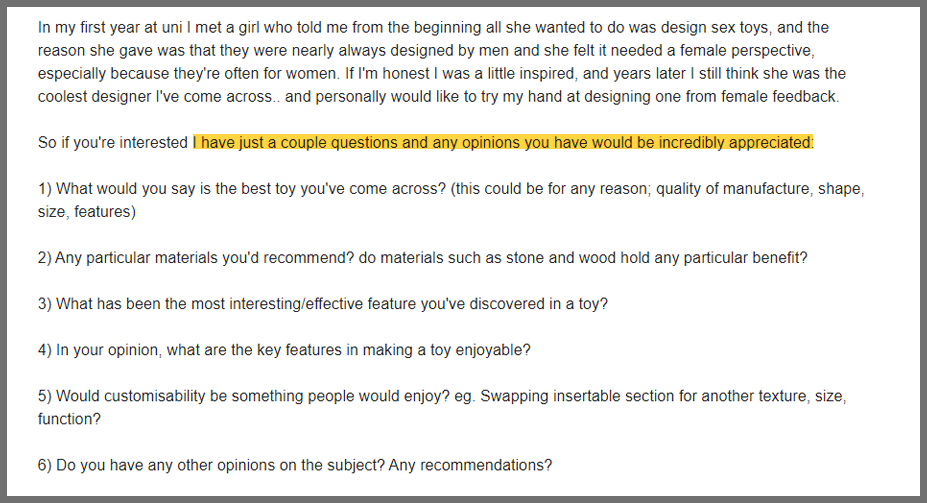
In the above email, a well-intentioned aspiring sex toy start-up asks for my opinion on how to create the perfect sex toy.
No payment to speak of, just an expectation that I should spend quite a bit of time explaining the ins and outs of sex toys and what makes them good and what doesn’t, and what materials to use, and how people may or may not like them.
In other words, the designer wants me to conduct his market research for him.
I’ve also received emails from companies who want me to go through their online stores and give them my feedback on if/how their layouts will suit potential customers. Again, for free.
Or there are the dozens of emails asking for free feedback on work-in-progress e-books or guides, like the ones below:
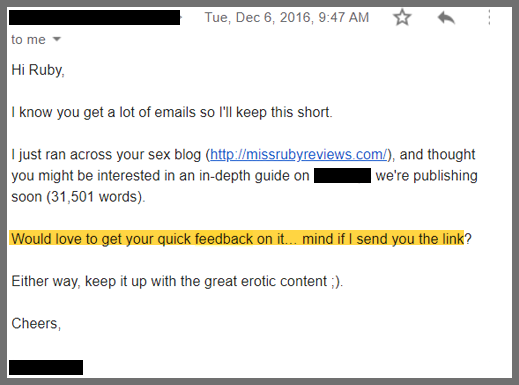
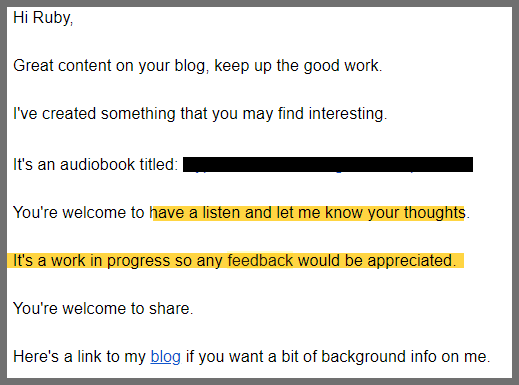
These kinds of emails are, actually, requests for professional consultation. There’s zero consideration for paying for our time as a blogger, or the accumulation of experience we bring. It’s assumed that we won’t mind helping every single sex toy start-up make a profit in the industry.
Requests for free consultation are relentless and, frankly, emotionally exhausting. There’s no end to them. You’ll get a lot of these over the years.
I love helping readers find a toy that suits them, certainly, but no one in their field should be expected to provide free consultations to a retail company. If it’s something you feel passionately about and don’t mind providing an unpaid consultation on, go for it — but otherwise, you should charge for your expertise.
Tip!
Companies should pay for your feedback/consultation on things that’ll help them make more money (i.e., sex toy designs or store layouts). Ask for payment upfront if this is something you’re interested in doing. Many bloggers provide paid consultations! Your time pouring over sex toy designs and learning about materials is actually very valuable — and you shouldn’t be expected to constantly provide advice to stores for free.
(9) “Join our affiliate program and promote us!”

I’ve gotten hundreds of requests to join companies’ affiliate programs over the years.
What’s in it for the companies? When you become their affiliate, companies hope that you’ll place lots of affiliate links on your blog and mention them in all your sex toy sales posts (like your Black Friday Deals Round-Up page, etc). This’ll obviously increase their visibility.
The problem is that affiliate relationships only ever work for the blogger when there’s a long-term, interactive (both-sides) collaboration.
How do you spot a good request from a bad one?
A good pitch for you to join a company’s affiliate program should come with a few important things.
- First, their website should meet your quality standards. Do they sell bodysafe products? Do they have a sex-positive website design?
- Second, their offer should come with an offer of additional forms of collaboration. For example, the company offers to sponsor a review on your blog, or a giveaway, or banner advertising in addition to an affiliate relationship. For me this is is critical (and mostly symbolic). It shows me that they’re willing to put a little bit of legwork into the relationship as well — rather than it just being one-sided.
- Third, their affiliate manager seems on the ball and totally interested in working WITH you, not just having you work FOR them. Do you like the contact person you’ll be dealing with? If they give you a bad vibe, back away. Trust your gut.
- Next, consider the commission percentage. I’ve been offered as low as 2% and as high as 30%. I recommend prioritizing companies who offer 15%+.
- Lastly, check out their cookie duration. 90 days is great… 30 days is most common… 7 days is very bad.
What you’re looking for here is the chance of a long-term relationship with a solid, upworthy company that will HELP you get links (ie, through review items), rather than just demand you place their links all over your blog.
What makes a bad pitch to join a company’s affiliate program?
Even if they have the “Good pitch” items above, keep an eye out for red flags. The biggest red flag is when a company insists and wants to dictate how you insert affiliate links on your blog. In my first few months of blogging, I once had a company snap at me for not placing their banner on my sidebar as soon as I was accepted into their affiliate program — nevermind that they hadn’t provided me anything in return. This is unacceptable.
Why do I have these guidelines in place? If I agreed to every affiliate relationship I’ve been offered, I’d literally have hundreds of ads everywhere on my blog, providing links to companies I virtually have no tangible connection to. It’d be awful, and it’s super hard to keep track of. I much prefer developing close, long term relationships with a few favourites, and fostering those relationships carefully.
Tip!
Don’t fall into the trap of: You’re our new affiliate = Provide us ongoing free advertising even though you’ll never hear from us again. It’s so important that you join companies when the affiliate program looks promising. If you join everything you’re offered, you’ll really dilute and disorganize your list of relationships, and be unable to foster the ones you should.
Last words of advice:
First, it’s good to start thinking like this (ie., protectively about your time and resources) early on. When I was new, I didn’t really realize the value that bloggers have, so I agreed to way more stuff than I should have. This led to an early bad habit of churning out work for free. Not only was this a tricky pattern to stop, but it also brought unnecessary frustration, disappointment, and time constraints to my first year. By limiting the amount of “for exposure” jobs you take on, you leave more time to actually work on valuable content for your readers that you’re proud of.
Second, in my experience, for every 1 decent pitch for collaboration you get from a company you haven’t met before, you’ll get 30+ bad pitches. So prepare to fine-tune your critical eye!
Third, when being asked to slice out a section of your blog to a company (i.e., for a guest post), a good rule of thumb is to treat your blog like your living room window. You wouldn’t let a random stranger put a billboard in your window, facing the street for the world to see, unless you felt appropriately compensated and/or you believed in them passionately.
Lastly, ALWAYS remember to respect your knowledge, your blog, and the hard work you’ve put into it making it your own!
Coming across weird email pitches and not sure what their deal is? Comment below and I’ll give you my feedback on them!

Other posts in this series:
- Setting everything up
- Your first reviews
- Affiliates
- Getting Products for Review
- Connecting with the Community
- When Companies Try to Trick You (here)
Last Updated on May 28, 2020 by Miss Ruby